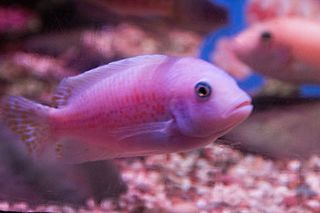
Cichlids are fish from the family Cichlidae in the order Cichliformes. Traditionally Cichlids were classed in a suborder, the Labroidei, along with the wrasses (Labridae), in the order Perciformes, but molecular studies have contradicted this grouping. On the basis of fossil evidence, it first appeared in Tanzania during the Eocene epoch, about 46–45 million years ago; however, molecular clock estimates have placed the family's origin as far back as 67 million years ago, during the late Cretaceous period. The closest living relative of cichlids is probably the convict blenny, and both families are classified in the 5th edition of Fishes of the World as the two families in the Cichliformes, part of the subseries Ovalentaria. This family is large, diverse, and widely dispersed. At least 1,650 species have been scientifically described, making it one of the largest vertebrate families. New species are discovered annually, and many species remain undescribed. The actual number of species is therefore unknown, with estimates varying between 2,000 and 3,000.

The Jack Dempsey is a species of cichlid fish that is native to freshwater habitats from southern Mexico to Honduras, but also introduced elsewhere. Its common name refers to its aggressive nature and strong facial features, likened to that of the famous 1920s boxer Jack Dempsey.

Protomelas taeniolatus is a Haplochromine cichlid endemic to Lake Malawi in Eastern Africa. The fish is popular in the aquarium hobby due to the bright rainbow-like colors of adult males and its relatively peaceful temperament. Juvenile and female P. taeniolatus, like many Haplochromines, do not display bright coloration.

The green terror is a colorful freshwater fish in the cichlid family. The fish originates from the Pacific side of South America from the Tumbes River in Peru to the Esmeraldas River in Ecuador. It is polymorphic and can have white or gold-orange edging to the tail and dorsal fins. It has historically been confused with two other species that always have narrow, clearly defined white edging, the more southerly distributed A. stalsbergi and the more northerly A. blombergi.

Parachromis is a genus of cichlids native to Central America. Some species occur in Lake Nicaragua and Lake Managua. All species are predatory and relatively large for cichlids.
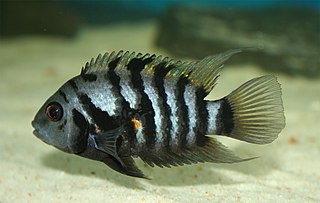
The convict cichlid is a fish species from the family Cichlidae, native to Central America, also known as the zebra cichlid. Convict cichlids are popular aquarium fish and have also been the subject of numerous studies on fish behaviour.

The poor man's tropheus is a species of fish in the family Cichlidae. Until 2007 it was the only species in the genus Neetroplus, but at that time it was reclassified into the genus Hypsophrys. In 2016 it was restored to the genus Neetroplus based on genetic research by Říčan, et al.

Melanochromis auratus, the auratus cichlid, is a freshwater fish of the cichlid family. It is also known as golden mbuna and Malawi golden cichlid. It is endemic to the southern region of Lake Malawi, particularly from Jalo Reef southward along the entire western coast down to Crocodile Rocks.

Nimbochromis livingstonii, Livingston's cichlid or (locally) kalingono, is a freshwater mouthbrooding cichlid native to Lake Malawi, an African Rift Lake. It is also found in the upper Shire River and Lake Malombe. They are found in inshore areas of the lake over sandy substrates.

Herotilapia multispinosa also known as the rainbow cichlid is a Central American freshwater fish of the cichlid family. It is found on the Atlantic slope of Honduras, Nicaragua, and Costa Rica from Patuca River (Honduras) south to Matina River, and on the Pacific slope of Nicaragua and Costa Rica from Guasaule River south to Tempisque River. Specimens are also reported from the Choluteca River on the Pacific side of Honduras. This species is found in lakes and swamps with muddy bottoms, where it uses its specialized teeth and only 3.5% jaw protrusion to feed mostly on algae. It is commercially important as an aquarium fish. The rainbow cichlid prefers a pH range of 7.0–8.0, water hardness of 9-20 dGH and a temperature range of 21–36 °C.

A freshwater aquarium is a receptacle that holds one or more freshwater aquatic organisms for decorative, pet-keeping, or research purposes. Modern aquariums are most often made from transparent glass or acrylic glass. Typical inhabitants include fish, plants, amphibians, and invertebrates, such as snails and crustaceans.
Parachromis motaguensis, the false yellowjacket cichlid, is a species of cichlid native to Central America, where it can be found in Guatemala, El Salvador, and Honduras. This species grows to a length of 30 centimetres (12 in) TL. This species is farmed.
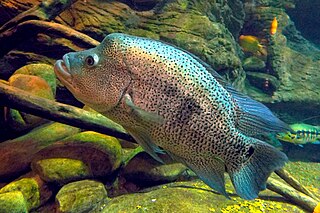
Parachromis dovii, the wolf cichlid, rainbow bass, or guapote, is a species of cichlid native to Central America, where it occurs in lakes, rivers and streams in Honduras, Nicaragua and Costa Rica. It is one of the largest cichlids, reaching up to 14 kg (31 lb) in weight and 80 cm (2.6 ft) long. A highly predatory species, it mostly feeds on other fish. P. dovii is important to local commercial fisheries, is sought after as a gamefish, and is sometimes kept in aquariums.

Parachromis friedrichsthalii, the yellowjacket cichlid, is a species of cichlid native to Central America, where it is found along the Atlantic Slope from western Honduras to northern Guatemala. This species grows to a length of 28 centimetres (11 in) SL. This species is popular with anglers as a gamefish and can also be found in the aquarium trade. The specific name honours the Austrian explorer, botanist and archaeologist Emanuel von Friedrichsthal (1809-1842), who sent many specimens to Vienna from Central America, including the type of this fish.

Apistogramma cacatuoides or the cockatoo dwarf cichlid is a South American cichlid and the Apistogramma species most commonly bred in captivity.

Amatitlania septemfasciata is a fish species in the cichlid family. It is found on the Atlantic slope of Costa Rica, between the San Juan River drainage and the Banano River. Several currently recognized cichlid species within the genus Amatitlania were formerly considered varieties of Amatitlania septumfasciata, including Amatitlania myrnae, the Topaz Cichlid, and Amatitlania cutteri.
The arrow loach is a species of ray-finned fish in the genus Nemacheilus.

Hoplias malabaricus, also known as the wolf fish, tiger fish, guabine or trahira, is a predatory Central and South American freshwater ray-finned fish of the characiform family Erythrinidae.
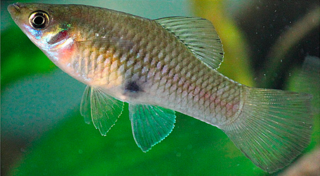
Phallichthys amates, the merry widow or merry widow livebearer, is a livebearer fish from Central America, the largest and most widespread in its genus. Two subspecies range from Guatemala to Panama. Distinguishing features include the dark dorsal fin edge, a stripe through the eye, and an oversized male copulatory organ (gonopodium).
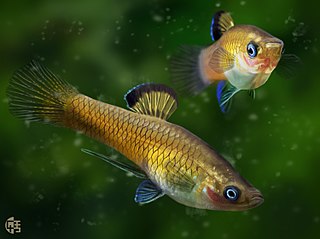
Phallichthys tico, the dwarf merry widow, is a livebearer fish from Central America. It lives in turbid, stagnant waters, often among aquatic plants, and feeds mainly on plant matter. It is sometimes kept in aquaria.



















